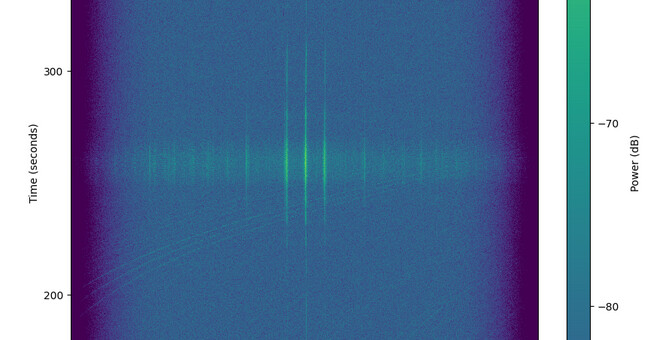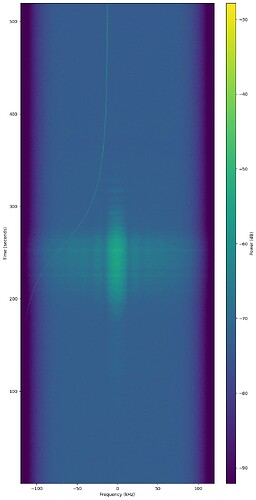WOW, you received those frequencies with the 75% reduced antenna?
SatNOGS Network - Observation 9053595 is NOAA 15 with reduced helicone and 2250 RHCP helical, no filter, no preamp.
SatNOGS Network - Observation 9050381 is NOAA 15 with 2250 RHCP and fixed reflector, (20 * 15 cm) with 2170-2300 bandpass followed by 22 dB preamp
There is another bpf on the way
Reducing the screw size from 2 to 1.5 mm is not advised however
SatNOGS Network - Observation 9053544 naked helicone
compared to filtered and amplified helical
https://network.satnogs.org/observations/9050333/
Curious what the filter / preamp adds to the helicone.
So, after vetting 24 hours of the reduced helicone with 5.2 turn RHCP 2250 helical, with 1400 MHz HPF and some 20 dB gain I found the results a bit better but still weak compared to the gain I noticed with the 1700 MHz helicone reflector and 1545 and 1700 MHz observations. So, this morning I decided to cut the 2250 Helical, back to a bit more as 2 turns. Left the filter and preamp and I notce the signals have increased in strenght and duration since this morning. Difficult to compare with other stations because of the pass elevation but for example LKW3 showed stronger as other helical stations in EU, and so did 31304 Aim this afternoon.
Now just for fun I rotated the helicone reflector 90 degrees , around it’s center ax.
Did you notice any difference?
Nope, appears to be quite symmetrical
Last thursday I did a small “addon” to the shortened helical. Calculated 1/4 radiator wavelenght for 2250 MHz with the formula my OM taught me over 40 years ago ![]() 71.37 / F in MHz, but decided to go for full so I multiplied that by 4 again. So I ended up soldering a 12.7 cm straight wire to the end of the helical, horizontal (I can allways cut it back to 31,7 mm in a couple of days). Placed the Helicone back up, rotating it so the added radiator points from East to West. First results show it does’t harm and appears to have improved some of the observations. Started obs on my 2 S-band stations this morning to compare a bit. Helicone now also has the Osmocomm bandpasfilter attached in front of the preamp.
71.37 / F in MHz, but decided to go for full so I multiplied that by 4 again. So I ended up soldering a 12.7 cm straight wire to the end of the helical, horizontal (I can allways cut it back to 31,7 mm in a couple of days). Placed the Helicone back up, rotating it so the added radiator points from East to West. First results show it does’t harm and appears to have improved some of the observations. Started obs on my 2 S-band stations this morning to compare a bit. Helicone now also has the Osmocomm bandpasfilter attached in front of the preamp.
So, after a lot of fun printing, assembling, testing, modifying antenna’s with both the 1700 MHz helicone and the reduced size 2250 helicone I decided to write my personal conclusion ![]()
For Satnogs observations in both the frequency ranges I noticed on average that the Helicone reflectors add a little bit extra to the bare helical setup. Most of the observations (2 hack rf’s) with the helicone add some 20 seconds more observation and (roughly guesstimated on the waterfall) about 3 dB of signal with the satellite passing overhead the helicone. Adding a quarter wave radiator to the 2250 helicone helicall appeared to make the results even a bit more better for the NOAA15 in 2250 MHz band.
Yesterday evening I decided to take the helicone away and redo some observation testing with a 55 cm lineair wifi dish. On average the results are worse compared to helicone and helical, but if I am right it shows that at least one satellite is using non RHCP polarisation , in this case ZHUHAI-1 03D as can be seen in the observations and images below.
Linear 2.4 GHz wifi dish SatNOGS Network - Observation 9103479
RHCP helical filter, preamp SatNOGS Network - Observation 9103327
same satellite, other pass, same results. This time as images
3442 lineair wifi dish

1433 RHCP

If I can find a weatherproof case for the 1700 MHz helicone I will point it to the Inmarsat (with 1545 RHCP helical) , the 2250 Helicone I will modify the antenna , and try both my homemade SHF Discone in the center, and the PCB version of the Logper I have.
As said, it’s still fun to do ![]()
